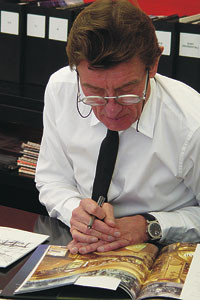Architect Jahn to take library project design beyond pragmatic purpose
By Julia MorseNews Office
 Helmut Jahn at work in his Chicago office. | |
Acclaimed architect Helmut Jahn, of the Chicago-based firm Murphy/Jahn, was chosen to design the $35.8 million addition to the Joseph Regenstein Library, which will be home to approximately 3.5 million volumes of the University’s print material, a reading room and a state-of-the art conservation lab.
Jahn’s accomplishments include the design of the Park Avenue Tower in New York City, the Hitachi Tower in Singapore, Chicago O’Hare International Airport United Airlines Terminal One, the Hyatt Regency Roissy in Paris, and the New European Union Headquarters in Belgium.
But the selection committee was impressed with more than Jahn’s resume Ð it also was impressed with his vision.
“How do you create harmony—by sameness or by compliment? Jahn sees a way for this structure to relate to the other buildings without being the same,” said Library Director Judith Nadler.
Jahn’s passion and confidence also helped him win the support of the committee.
“He truly impressed us as he spoke to this challenge with authority and conveyed a great enthusiasm,” Nadler said.
Since last May, the selection committee, including members of the University Board of Trustees, senior faculty members and University and Library staff, has been working toward this point. It was a highly competitive process, Nadler said.
Twenty-eight firms from around the world were approached initially, last June, and that group was narrowed to five for a series of interviews last fall.
“These were all very prominent architects and all extremely impressive,” Nadler said. “It was interesting to see how differently each envisioned this project.”
But it was Jahn whose appreciation for the structure impressed committee members the most.
“He is excited about extending Library space for books at a time when other university libraries are doing the opposite and moving books off-site,” Nadler said.
Jim Vaughan, Assistant Director of Access and Facilities for the Library, explained that universities including Harvard, Columbia, Yale and Brown, have moved large portions of library collections out of campus libraries and into storage facilities off-site.
“This opportunity here in keeping our print collections on campus and at Regenstein will make us extraordinarily distinct from other institutions,” Vaughan said.
The 38,200 square-foot building will be built immediately west of the Joseph Regenstein Library with the Henry Moore “Nuclear Energy” sculpture sitting to the north and 57th Street to the south.
Inside the structure will be a high-density automated shelving system, which will store print materials whose removal from shelving inside the library will have minimal effect on access to materials, Vaughan explained.
When a request is made for any material stored in the system, it will be retrieved by a crane within minutes, unlike the off-site storage facilities used by other institutions, where it can take until the next business day to receive requested material.
With the University accruing approximately 150,000 new print volumes every year, Nadler noted that Jahn’s design will be able to provide space for up to 22 years of new print materials acquired by the University.
“The mechanical shelving system is an additional challenge for the architect whose mission will be to marry technology with the aesthetics of construction and thereby create the wow-factor or the new building. A vendor has not yet been selected for the storage system, Nadler noted.
In a statement to the selection committee during an interview in October, Jahn acknowledged the great responsibility of the architect chosen for this project.
“Design is always a marriage between vision and realities, but without vision there cannot be excellence,” Jahn said. “Though the building is essentially a storage facility for books, its impact on the campus and the users has to go far beyond this pragmatic purpose.”
Jahn also noted the challenge of new construction on the historical campus of the University. “In a place with this much history, real newness cannot just be physically new, but needs to be so spiritually,” he said. “We believe that this can be achieved through an innovative attitude and ideas about advanced technology and sensibility toward energy and ecology. The result can be the library of the future.”
Groundbreaking is tentatively planned for August 2007.
![[Chronicle]](/images/sidebar_header_oct06.gif)